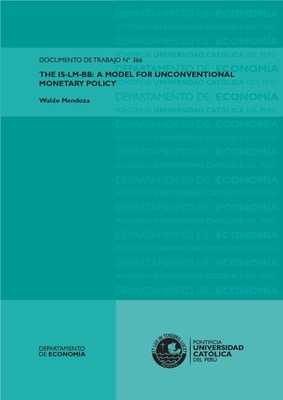| dc.contributor.author | Mendoza Bellido, Waldo Epifanio | |
| dc.date.accessioned | 2015-03-19T20:37:56Z | |
| dc.date.available | 2015-03-19T20:37:56Z | |
| dc.date.issued | 2013 | |
| dc.identifier.uri | http://repositorio.pucp.edu.pe/index/handle/123456789/47006 | |
| dc.description.abstract | La política monetaria en los Estados Unidos no es la misma desde la crisis internacional de 2008-2009. Con la crisis, debido a que la tasa de interés de los fondos federales- el instrumento convencional de política monetaria- se redujo hasta casi cero, la Reserva Federal (FED) tuvo que recurrir a dos instrumentos no convencionales. En primer lugar, el anuncio sobre la trayectoria futura de la tasa de interés de corto plazo. En segundo lugar, la intervención directa en el mercado de bonos de largo plazo. El objetivo de este artículo es extender modelo IS-LM creado por Hicks (1937), para incorporar las innovaciones de la política monetaria americana. Este modelo actualizado, a diferencia de la IS-LM, considera que la FED administra la tasa de interés de corto plazo, no la oferta monetaria, la cual es endógena. Por otro lado, para poder tratar la flexibilización cuantitativa, se añade un mercado de bonos de largo plazo a la IS-LM —en donde solo existe un mercado de bonos de corto plazo— recurriendo a Tobin (1981). El artículo es una muestra de que los viejos modelos y los viejos métodos son todavía muy útiles para tratar los problemas macroeconómicos contemporáneos. | es_ES |
| dc.description.abstract | The Monetary policy of the United States has not been the same since the 2008-2009 international crisis. Following the crisis, given that the federal funds interest rate – the conventional monetary policy instrument – fell to almost zero, the Federal Reserve (FED) had to resort to two unconventional instruments: Firstly, an announcement on the future trajectory of the short-term interest rate. Secondly, direct intervention in the long-term bond market. The objective of this article is to extend the IS-LM model devised by Hicks (1937), to incorporate American monetary policy innovations. This updated model, unlike IS-LM, takes into account that the FED administers the short-term interest rate, not monetary supply, which is endogenous. On the other hand, so as to address quantitative easing, a long-term bond market is added to the IS-LM —in which there only exists a short-term bond market— by resorting to Tobin (1981). This article shows that the old models and the old methods remain very useful in dealing with contemporary macroeconomic problems. | en_US |
| dc.language.iso | spa | es_ES |
| dc.publisher | Pontificia Universidad Católica del Perú. Departamento de Economía | es_ES |
| dc.relation.ispartof | urn:issn:2079-8466 | |
| dc.relation.ispartof | urn:issn:2079-8474 | |
| dc.relation.ispartofseries | Documento de Trabajo;366 | es_ES |
| dc.rights | info:eu-repo/semantics/openAccess | es_ES |
| dc.rights.uri | http://creativecommons.org/licenses/by-nc-nd/2.5/pe/ | * |
| dc.subject | Política monetaria | es_ES |
| dc.title | The IS-LM-BB: a model for unconventional monetary policy | es_ES |
| dc.title.alternative | IS-LM-BB: Un modelo de política monetaria no convencional. | es_ES |
| dc.type | info:eu-repo/semantics/workingPaper | |
| dc.type.other | Documento de trabajo | |
| dc.subject.ocde | http://purl.org/pe-repo/ocde/ford#5.02.00 | |
| dc.publisher.country | PE | |
| renati.advisor.orcid | https://orcid.org/0000-0001-9422-7908 | |


